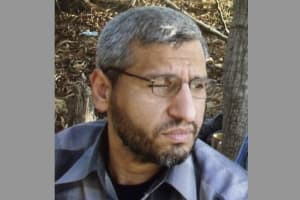Palestinians inspect the damage after an Israeli airstrike in the Al-Mawasi area near Khan Younis, July 13, 2024; insert: Mohammed Deif (Photo: Abed Rahim Khatib/dpa via Reuters)
Israeli officials are continuing to investigate the confirmation of Mohammed Deif’s death following an airstrike on Saturday afternoon. The strike targeted the Hamas senior military commander, Deif, and his deputy Rafa’a Salameh in Khan Younis in Gaza.
An Israeli official told The Wall Street Journal it could take days or weeks to determine whether Deif was killed in the attack.
Israeli officials have been cautious about making any claims due to multiple previous attempts to eliminate Deif which were unsuccessful. Initially, the IDF did not even provide the names of the targeted individuals, saying only that Israeli forces “carried out a strike in an area where two senior Hamas terrorists and additional terrorists hid among civilians.”
Both Hamas and Israel confirmed Salameh’s death on Sunday, while Hamas denied that Deif had been killed in the strike.
If Deif was eliminated in the strike, he would be the highest-ranking Hamas leader to be killed during the war in Gaza.
Israel appears to be taking a “wait and see” approach regarding whether Deif was killed, as confirming his death quickly would likely require the use of some of the same intelligence assets used to discover Deif’s location. Because the discovery relied on both signal intelligence and human intelligence, according to statements made by IDF Chief of Staff Herzi Halevi on Sunday evening, Israel is likely not willing to expose the human intel sources, preferring to wait for Hamas or others to confirm the death.
Speaking at the Palmachim Air Force base on Sunday, Halevi said: “It is still too early to summarize the results of the attack, which Hamas is trying to hide. We are determined to continue to persecute senior Hamas officials, those who planned and carried out the massacre of October 7.”
A New York Times report revealed that the IDF and Shin Bet had been monitoring the location of the strike after discovering Salameh’s presence there. Because Salameh was Deif’s deputy, Israeli officials hoped that Deif might visit for planning and coordinating. Due to health issues, officials believed that Deif was not able to spend an extended period underground and would likely seek a safe place.
Officials estimate that both Deif and Salameh did not believe Israel would attempt a strike on the compound due to its location in the humanitarian zone and the ongoing hostage ceasefire negotiations, which appeared to be close to a breakthrough.
After receiving notification on Friday night that Deif was indeed at the site, Israeli Prime Minister Benjamin Netanyahu approved the operation. In the morning, after receiving additional confirmation about his presence at the location, Israeli Air Forces (IAF) fighter jets were deployed to Gaza.
The strike itself reportedly involved multiple types of munitions, including bunker-buster bombers meant to prevent the use of tunnels to reach or escape the compound.
According to Saudi news site Al Hadath, Hamas is currently investigating a major breach in its ranks that may have allowed collaborators access to information about Deif’s whereabouts, which was then shared with Israel ahead of the strike.

































